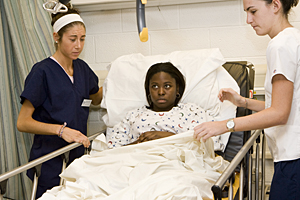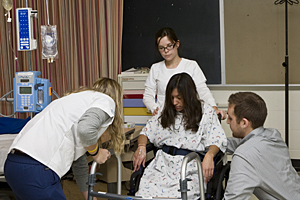Javascript is required to view this video


ADVERTISEMENT
- Rozovsky wins prestigious NSF Early Career Award
- UD students meet alumni, experience 'closing bell' at NYSE
- Newark Police seek assistance in identifying suspects in robbery
- Rivlin says bipartisan budget action, stronger budget rules key to reversing debt
- Stink bugs shouldn't pose problem until late summer
- Gao to honor Placido Domingo in Washington performance
- Adopt-A-Highway project keeps Lewes road clean
- WVUD's Radiothon fundraiser runs April 1-10
- W.D. Snodgrass Symposium to honor Pulitzer winner
- New guide helps cancer patients manage symptoms
- UD in the News, March 25, 2011
- For the Record, March 25, 2011
- Public opinion expert discusses world views of U.S. in Global Agenda series
- Congressional delegation, dean laud Center for Community Research and Service program
- Center for Political Communication sets symposium on politics, entertainment
- Students work to raise funds, awareness of domestic violence
- Equestrian team wins regional championship in Western riding
- Markell, Harker stress importance of agriculture to Delaware's economy
- Carol A. Ammon MBA Case Competition winners announced
- Prof presents blood-clotting studies at Gordon Research Conference
- Sexual Assault Awareness Month events, programs announced
- Stay connected with Sea Grant, CEOE e-newsletter
- A message to UD regarding the tragedy in Japan
- More News >>
- March 31-May 14: REP stages Neil Simon's 'The Good Doctor'
- April 2: Newark plans annual 'wine and dine'
- April 5: Expert perspective on U.S. health care
- April 5: Comedian Ace Guillen to visit Scrounge
- April 6, May 4: School of Nursing sponsors research lecture series
- April 6-May 4: Confucius Institute presents Chinese Film Series on Wednesdays
- April 6: IPCC's Pachauri to discuss sustainable development in DENIN Dialogue Series
- April 7: 'WVUDstock' radiothon concert announced
- April 8: English Language Institute presents 'Arts in Translation'
- April 9: Green and Healthy Living Expo planned at The Bob
- April 9: Center for Political Communication to host Onion editor
- April 10: Alumni Easter Egg-stravaganza planned
- April 11: CDS session to focus on visual assistive technologies
- April 12: T.J. Stiles to speak at UDLA annual dinner
- April 15, 16: Annual UD push lawnmower tune-up scheduled
- April 15, 16: Master Players series presents iMusic 4, China Magpie
- April 15, 16: Delaware Symphony, UD chorus to perform Mahler work
- April 18: Former NFL Coach Bill Cowher featured in UD Speaks
- April 21-24: Sesame Street Live brings Elmo and friends to The Bob
- April 30: Save the date for Ag Day 2011 at UD
- April 30: Symposium to consider 'Frontiers at the Chemistry-Biology Interface'
- April 30-May 1: Relay for Life set at Delaware Field House
- May 4: Delaware Membrane Protein Symposium announced
- May 5: Northwestern University's Leon Keer to deliver Kerr lecture
- May 7: Women's volleyball team to host second annual Spring Fling
- Through May 3: SPPA announces speakers for 10th annual lecture series
- Through May 4: Global Agenda sees U.S. through others' eyes; World Bank president to speak
- Through May 4: 'Research on Race, Ethnicity, Culture' topic of series
- Through May 9: Black American Studies announces lecture series
- Through May 11: 'Challenges in Jewish Culture' lecture series announced
- Through May 11: Area Studies research featured in speaker series
- Through June 5: 'Andy Warhol: Behind the Camera' on view in Old College Gallery
- Through July 15: 'Bodyscapes' on view at Mechanical Hall Gallery
- More What's Happening >>
- UD calendar >>
- Middle States evaluation team on campus April 5
- Phipps named HR Liaison of the Quarter
- Senior wins iPad for participating in assessment study
- April 19: Procurement Services schedules information sessions
- UD Bookstore announces spring break hours
- HealthyU Wellness Program encourages employees to 'Step into Spring'
- April 8-29: Faculty roundtable series considers student engagement
- GRE is changing; learn more at April 15 info session
- April 30: UD Evening with Blue Rocks set for employees
- Morris Library to be open 24/7 during final exams
- More Campus FYI >>
8:13 a.m., Nov. 23, 2009----The University of Delaware's newest collaborative effort on campus brings together strange bedfellows -- the departments of Theatre and Physical Therapy and the School of Nursing.
Undergraduate theatre students are becoming standardized patients, healthy lay people who are trained to portray a patient with a particular condition.
“We typically use mannequins for simulation,” said Amy Cowperthwait, a School of Nursing laboratory coordinator, “but those mannequins are not able to communicate or portray the verbal or neurologic status of a patient.”
Standardized patients are trained to present not just the health history of a patient but also demonstrate the body language, emotions, personality, and relevant physical findings. The realistic interactions provide student healthcare workers with real-time feedback in an environment free of consequences.
“As much as we can practice on each other, nobody can do what they did, nobody can pretend like that,” said Meredith Link, a physical therapy graduate student.
Link is among the group of physical therapy and nursing students who practiced their healthcare delivery skills on the standardized patients during a two-week session this month.
The standardized patient theatre students portrayed patients with head or spinal cord injuries. Part of their training involved observing similar patients at the University of Delaware Neurologic and Older Adult Physical Therapy Clinic on campus and at the Johns Hopkins Hospital in Baltimore and at Christiana Care's Wilmington Hospital.
“This is an opportunity to study the real patients over a period of time and then enact it in a real situation, not on the stage, with real people,” said Allan Carlsen, supplemental faculty in the Department of Theatre. “The actors have the challenge of maintaining the character and the integrity of the role that they're playing.”
The standardized patient model is used by medical schools nationwide, but rarely in undergraduate programs, and almost never with the help of a college's theatre department.
The collaboration is one of the first of its kind integrating departments whose talents are valuable to one another but who rarely cross paths.
The varied students and faculty involved said they believe the experience will propel their skills forward, resulting in better performances both on and off the stage.
Article by Andrea Boyle
Photos by Ambre Alexander


